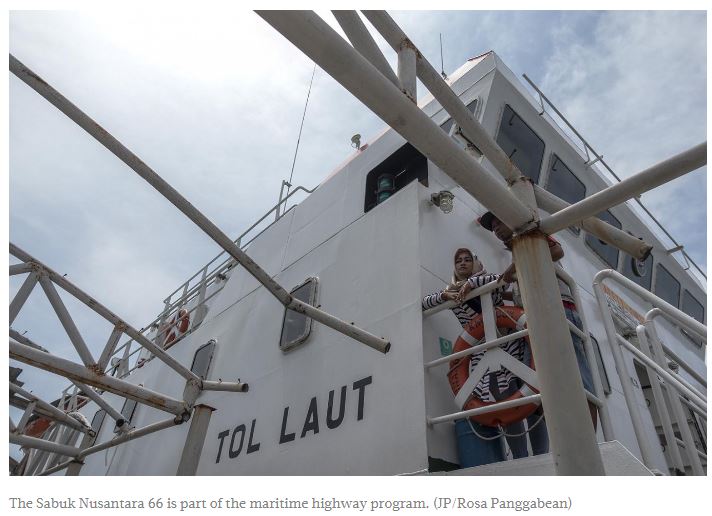Indonesia: Lack of return cargo from destination ports remains challenge for maritime highway
Cargo ships returning empty from destination ports is a core challenge for the government’s so-called maritime highway five years after its initiation, officials and experts say.
The maritime highway program subsidizes shipping on certain routes for the distribution of basic and important consumer goods as well as steel and cement to remote regions of the archipelago.
The Transportation Ministry’s sea transportation director general, Agus Purnomo, said Monday that the government should do more to boost local industries in the program’s destination regions and increase the return cargo volume.
“We need to establish a system to increase the return cargo volume. Return cargo is still the maritime highway’s weakness, and we have to create new products in the destinations to be shipped to the ports of origin,” he said during a virtual book launch held by Kompas.
To boost return cargo volumes from destination regions, Agus said the Transportation Ministry, alongside the Trade Ministry, would utilize and integrate the “Rumah Kita” (Our Home) program and the “Maritime Store” program.
Rumah Kita is a government-initiated program implemented by state-owned shipping companies including PT Pelindo I, II, III and IV, PT Pelni and PT ASDP that provides warehousing and inventory services to store and consolidate the commodities along the maritime highway routes.
Meanwhile, Maritime Store is a Trade Ministry initiative to facilitate basic goods distribution to outermost regions that are pegged to the maritime highway program.
“We could use the Rumah Kita program and Maritime Store depots to trigger return cargo volume growth and improve connectivity in eastern Indonesia. In the next four years, we will continue to develop these programs and create a sustainable system to increase return cargo volumes,” Agus said.
Despite Agus’ optimism regarding the Rumah Kita and Maritime Store programs, 10 November Institute’s (ITS) maritime expert Saut Gurning said both programs were “inward-looking” and focused on stabilizing basic goods prices rather than developing local industries.
He said the programs only collected and stored products from port destination regions and did not explore potential products that could be shipped from the regions.
“I’m not saying that the Maritime Store program is a failure. The program has an inward-looking nature, because it was made to fulfill the Maritime Highway’s initial target [of price stabilization] in remote regions,” he told The Jakarta Post.
According to his calculation, the maritime highway’s return cargo load factor only hovered around 15 percent of its maximum capacity due to low demand from the destination regions.
“We need to add more outward-looking programs to boost return cargo volumes. If we could increase the volume, the subsidy would be significantly reduced and residents of destination regions could experience significant economic growth,” he said.
The ministry has allocated Rp 436 billion (US$29.7 million) to subsidize the maritime highway program this year, up Rp 136 billion from last year, to accommodate seven additional routes, bringing the total number to 26 routes. As of mid-September, the ministry has spent 40 percent of the allocated budget.
According to the newly published book, titled “Tol Laut, Konektivitas Visi Poros Maritim Indonesia” (Maritime Highway, the Connectivity of Indonesia’s Maritime Fulcrum Vision) the program has been successful in pushing down basic goods prices by 20 percent in Anambas Island regency, Riau Islands, and Wakatobi regency in Southeast Sulawesi.
The maritime highway has also reduced basic goods prices in Tidore Island, North Maluku, by 14 percent and in Fakfak regency, Papua, by 10 percent.
During the event, Transportation Minister Budi Karya Sumadi said President Joko “Jokowi” Widodo had instructed the ministry to coordinate stakeholders in improving the maritime highway program.
“We hope to achieve a balance between eastern and western [Indonesia], where we deliver goods to eastern regions to push down prices and ship products from eastern regions,” the minister said.
Source: https://www.thejakartapost.com/news/2020/09/24/lack-of-return-cargo-from-destination-ports-remains-challenge-for-maritime-highway.html


 Thailand
Thailand




